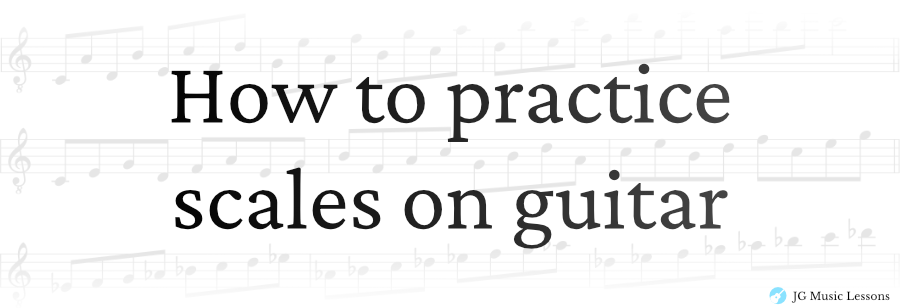As guitarists, mastering scales is essential for playing melodies and improvising. You’ve probably heard it over and over: “Knowing scales is important!” But how can we practice them effectively to really make our playing shine?
While knowing the notes of a scale is a crucial first step, the next challenge is learning how to apply them musically. In this lesson, we’ll explore different exercises and tips to help you practice guitar scales in a more creative and effective way. Here’s a quick overview of what we’ll cover:
- Mastering scale shapes
- Practicing scale patterns
- Practicing scale intervals
- Practicing scale arpeggios
- Playing scales over chord progressions
- Playing scales over key changes
- Practice scales with a metronome
- Transcribing
By learning these exercises, you’ll unlock more creative ways to practice scales and gain confidence in improvisation. If you’re already familiar with the notes on the guitar fretboard, let’s dive into these concepts and start mastering your scales!
* Free for Pro Members
1. Mastering scale shapes
One of the benefits of knowing scale shapes is that it gives you the freedom to play anywhere on the fretboard without limitations. You can think of them as a grid or map for you to choose the right notes of a scale.
Playing scale vertically
Since the same notes are repeated throughout the fretboard, we can learn the scale by dividing it into different sections, also known as a “scale shape” where we can play 2 or 3 notes per string. We can think of this as playing the scale vertically because we play the notes from the lowest to highest strings and vice versa.
For example, once you learn the 5 Major scale shapes, you can then apply the shapes to any key. If you master the shapes in one key, then it’s simply a matter of playing the same shapes on different starting points for other keys.
I recommend learning the C Major scale first because it’s the key signature that doesn’t have any sharp or flat notes.
How to read the scale charts
For the charts below:
- The lowest horizontal line represents the thickest string (Low E). The top horizontal line represents the thinnest string (high E).
- The green circles represent the root note of the scale and the blue notes are every scale note in between.
- The numbers inside the circles represent the suggested fingering to use on your fretting hand.
If needed, check out how to read guitar notation symbols.
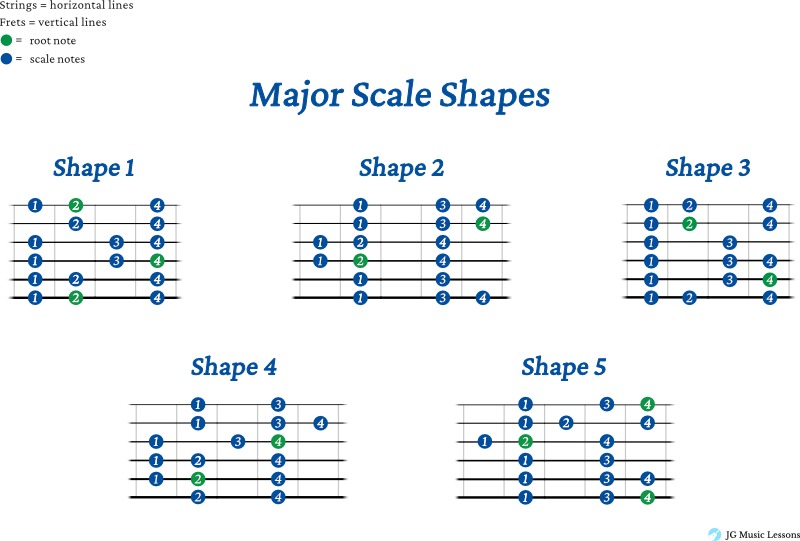
After reviewing each scale shape on the fretboard, start to memorize one at a time until you don’t need to look at any music or paper to help you. Try to visualize how the notes repeat on each string set and review the shapes often until you have them all memorized.
You can apply this concept of memorizing shapes for any scale, whether it’s the minor scale, pentatonic or blues scale. Working on memorizing and reviewing scales is a great way to start a practice session.
Connecting scale shapes
To get more comfortable using a scale, the next step is to learn to play it between positions throughout the fretboard. You might have to work out new fingerings that are more comfortable to switch between scale shapes. However, if you are familiar with each scale shape, then connecting the notes will be much easier.
For example, here is one way to connect the notes of a pentatonic scale across several shapes.
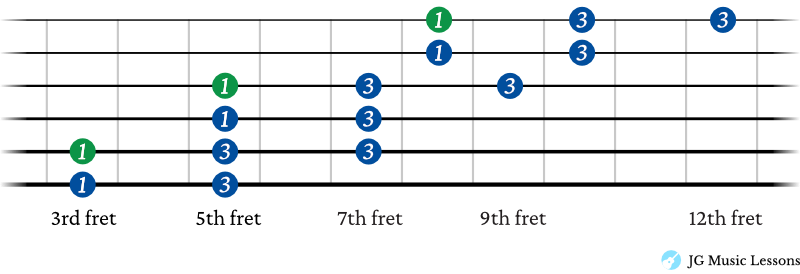
Playing scales horizontally
Another less conventional way to practice a scale is to play the notes horizontally across one string. Although you don’t typically play scales this way, there are times when you simply need to stay on the same string to move across the fretboard. This is especially the case when you’re ascending on the 1st string.
For example, this is what the notes of the E minor scale would look like horizontally across the 1st string below. You can also think of this as a G Major scale starting on the 6th degree.

2. Practicing scale patterns
After you’re comfortable playing all the shapes of a scale on the fretboard, you can try the following exercises to help you break out of playing the notes consecutively. They’re also great warm up exercises that add interest to your playing and they also reinforce your ability to play a given scale.
I recommend learning the 5 Major scale shapes on guitar before working on these patterns.
Here are some examples of scale patterns that you can practice.
3 consecutive scale notes pattern
The numbers below represent the degrees of the scale. This pattern goes like this:
1, 2, 3, then, 2, 3, 4, then, 3, 4, 5, etc…
In C Major, this would be the notes: C, D, E, then, D, E, F, then, E, F, G, etc…
Try playing the 3 consecutive note scale pattern in C Major below.
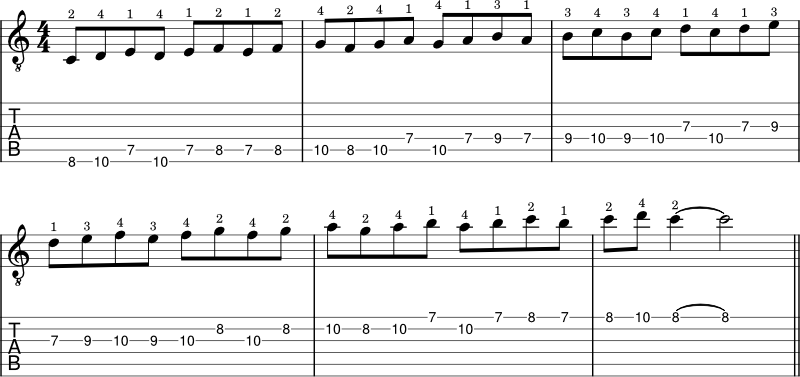
This example shows an ascending 3 note pattern but you can also try this in descending order.
4 consecutive notes pattern
The 4 consecutive notes pattern in scale degrees would be:
1, 2, 3, 4, then, 2, 3, 4, 5, then, 3, 4, 5, 6, etc…
In C Major, this would be the notes: C, D, E, F, then, D, E, F, G, then, E, F, G, A, etc…
Try playing the 4 consecutive note scale pattern in C Major below.
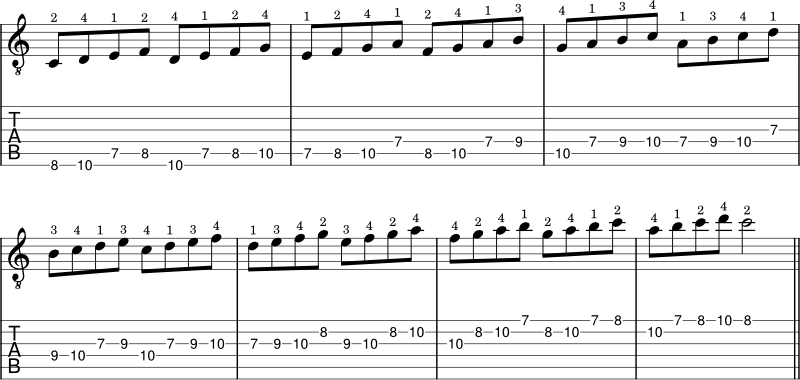
After learning these previous patterns, you can also try practicing consecutive 5 or 6 scale note patterns.
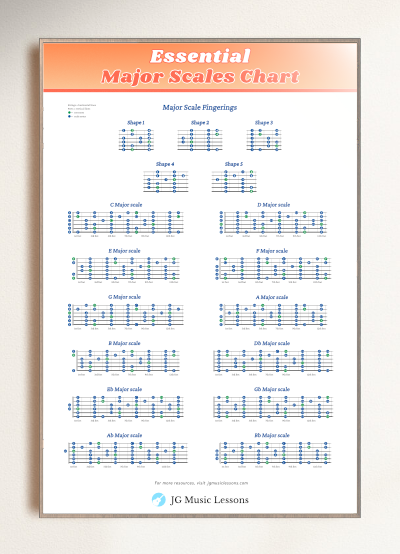
3. Practicing scale intervals
For the following scale interval examples, we’ll be using a C Major scale but the concept can be applied to any scale. The numbers above the notation examples represent suggested fingerings for your fretting hand.
Scale in interval of thirds
Using scale degree numbers, the pattern for intervals of thirds would be:
1, 3, then, 2, 4, then, 3, 5, etc…
In C Major, this would be the notes: C, E, then, D, F, then, E, G, etc…

For the previous example, we are ascending on each scale note.
However, you could also try these variations:
- Descending order of third intervals like this: 3, 1, then, 4, 2, then, 5, 3, etc…
- Alternate on each scale note (ascending, descending order) like this: 1, 3, then 4, 2, then 3, 5, etc…
- Alternating variation (descending, ascending order) like this: 3, 1, then, 2, 4, then, 5, 3, etc…
Scale in interval of 4ths

Again, you could explore all the variations I mentioned previously (descending and alternating orders) with all of these different scale intervals to get the most out of these exercises.
Scale in interval of 5ths

Scale in interval of 6ths

Scale in interval of 7ths

Octave intervals

Scale in interval of 10ths

*Free for Pro Members
4. Practicing scale arpeggios
An arpeggio is when you break up the notes of a chord. In this case, we’ll be playing triad chords within one scale. Triad chords can be played by starting on any scale degree using this concept: note, skip a note, note, skip a note, note. For example, a C Major triad is C, E, and G (we skipped the notes D and F).
Using the C Major scale you naturally get the following triad chords. These are also known as diatonic chords, which simply means the related chords coming from one scale.
- C Major – C, E, G
- D minor – D, F, A
- E minor – E, G, B
- F Major – F, A, C
- G Major – G, B, D
- A minor – A, C, E
- B diminished – B, D, F
You can review these lessons to learn how to play Major triads or minor triads on guitar. The following example will show you how to practice arpeggios on guitar using diatonic triad chords in C Major.
Triad chord arpeggios

Keep in mind that these examples show the scale in one position but I encourage you to practice these scale concepts throughout the fretboard.
7th chord arpeggios
We can take this one step further and add another scale note to the triads. If we skip one more note in the scale, we get what are called 7th chords. Here are the diatonic 7th chords in C Major.
- C Major 7 – C, E, G, B
- D minor 7 – D, F, A, C
- E minor 7 – E, G, B, D
- F Major – F, A, C, E
- G Major – G, B, D, F
- A minor – A, C, E, G
- B half diminished – B, D, F, A
Here is the exercise for diatonic 7th chords in C Major below.

Again, you could also practice these triads and arpeggios in descending and alternating orders. If needed, check out how to play Major 7 arpeggios, Dominant 7 arpeggios, minor 7 arpeggios or half diminished chords on guitar.
5. Playing scales over chord progressions
This is the fun part of the learning process. Try playing the scale you’re working on over a related chord or series of chords to start creating melodies and practice connecting all the shapes of a scale throughout the fretboard.
You can get started with the diatonic chords mentioned in the previous section to get started creating chord progressions in the key of C Major or A minor since they are related.
A great way to practice this is to record some chords that you can then playback in a program like Garageband or a more in depth program like Logic Pro X.
You can also take a phrase or melody and try applying the idea to a chord progression. Challenge yourself to play the same riff or melody in different areas of the guitar. Also experiment with changing different notes and rhythms to make variations in your musical phrases.
6. Playing scales over key changes
A fun and challenging way to practice scales is to work on playing them over different keys. Once you know the scale shapes and you are comfortable moving between them, you have to learn to shift to a new key as the chords change.
Here is an example of practicing scales over a cycle of chords. After every scale, we’ll shift the starting point up an interval of a fourth.
Scale over a cycle of 4ths

I suggest practicing scales over different cycles of chords to take you out of your comfort zone. Maybe you can try ascending or descending whole steps, 3rds, 5ths, or 6ths. The goal is to get to a point where you can play any scale no matter the musical situation.
7. Practice scales with a metronome
Developing speed and rhythm
Here is a suggested exercise for how to practice guitar scales using a metronome (you can use this free metronome on our site).
- Start at a slow and comfortable tempo to practice a scale in one position of a scale that you want to learn.
- Make sure you can play all the notes from the lowest to highest string without any mistakes and with a clear tone.
- Increase the tempo by 5 bpm (beats per minute) and try the scale again.
- Keep increasing the tempo until it you find that your technique or tone isn’t keeping up with the tempo. At this point, pull the tempo back to find a sweet spot that is just challenging enough for effective practice.
Changing beat numbers on the click
When using a metronome to practice, it is very common to hear each click as one beat. Instead of hearing the click as (1, 2, 3, 4) you can set it at half the speed and think of the click as beats 1 and 3 which repeat. You can also do the same by thinking of the click as beats 2 and 4 to shift the perspective of the timing.
By spacing out the sound of the click, you challenge your ability to keep consistent time. This can also simulate the gaps that occur when playing in different situations, whether you’re practicing over a backing track or playing in a live setting.
Changing note rhythms
Another idea for practice scales is to try playing different rhythms over the metronome. For example, you start with 2 notes of the scale for every click. Then you could other variations like 3, 4, or 6 notes for every click.
Adjust the tempo to something that is just comfortable or just challenging enough. The point is to be able to hear and play the scale using different rhythms to use it more flexibility when playing melodies or for improvisation.
If possible, I suggest practicing this rhythm exercise with a backing track for a more musical application of this concept. It can make your practice more engaging and fun to work on different rhythmic ideas on the guitar.
8. Transcribing
Transcribing is learning to play what you hear on your instrument. This can apply to learning a short riff, a melody, or an entire solo. The point of transcribing is to extract musical information so that we can learn from it and apply it in our playing. For an example of this, check out these 7 jazz and blues licks over a dominant 7 chord.
Transcribing can be even more effective if you can notate the music to analyze it visually and also for reviewing it later on. Through this process, you get to understand how scales are used over certain chords so that you can develop those ideas in your playing.
You can learn to identify what makes a phrase or solo sound good by taking a closer look at a musician’s note choices, patterns, and even tone. As soon as you can do this, I suggest trying to transcribe different riffs or melodies from your favorite songs.
For more on this, you might want to check out this post on how to develop ear training to play what you hear.
Wrapping up
We covered several ways to practice guitar scales using concepts such as patterns, arpeggios, and intervals. As you incorporate some of these exercises in your daily practice, you’ll get more comfortable playing melodies or soloing more freely on guitar.
It’s very helpful to work out different ways of practicing scales so we can go beyond just knowing the notes and learn to be more flexible using them. Working out creative ways to practice scales is a process that takes time but is definitely worth the effort once you’re able to play and communicate your musical ideas.
If you’re interested in learning more, check out these 9 tips to get better at improvising on guitar.
📘 Get the free guitar practice guide here!
All the best,
JG Music Lessons
📙 Kickstart your guitar playing with our step by step guide: Guitar Essentials.
🎸 Looking for a travel or half-sized guitar? See this one.
🛠 See our other music recommendations.
🤝 Support the site to help us to create better content for you!
Level up with the FREE guitar practice guide and effectively improve your playing! 🎸
Get it sent to your email!

